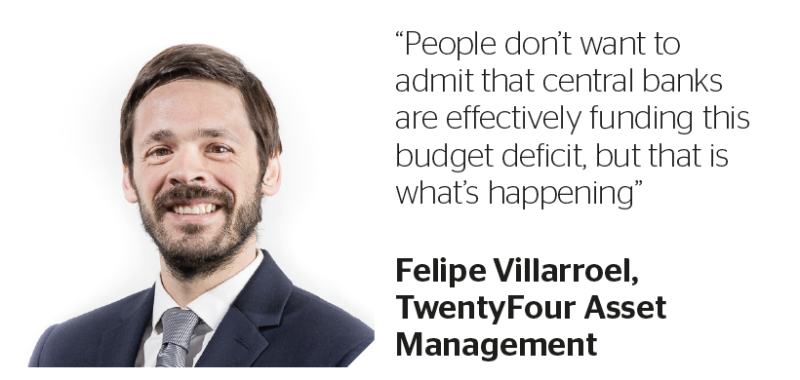The immediate focus right now is on the health crisis, but already there is talk of how governments should deal with the increased debt loads. But the contour lines of the debate are etched very different to how they were after the financial crisis a decade ago.
Attempting to pay the debt down quickly through tax rises or spending cuts is likely to be very politically unpopular beyond a certain point, particularly in countries hit by austerity last time, and particularly given the ‘act of God’ nature of the virus. This makes it difficult to form a crude moral narrative about reckless borrowing. At the other end of the spectrum, restructuring the debt or defaulting would also be deeply contentious.

This leaves the option of keeping the debt on the books and letting growth or inflation winnow down its significance over time. And many recognise it as a feasible and attractive choice this time around.
How come? Well, firstly, governments can service debt cheaply — Germany’s 10 years Bunds are at -0.59%, for instance — a function of low interest rates and quantitative easing programmes. On its own, this is not a watertight argument for being relaxed about high debt levels. Inflation may pick up, leading to higher bond yields in the expectation of rate rises, and thus higher borrowing costs.
However, in reality, rate rises look to be some way off, because this would require both inflation jumping (there is scepticism about the immediate chances of this, especially in some countries) and central banks acting to nip that inflation in the bud.
The US Federal Reserve said in August that, rather than targeting 2% inflation at all times, it will instead look for an average of 2% over time, meaning it will allow inflation to overshoot that level to make up for a period of low inflation. It is thought that other central banks are likely to tolerate higher inflation too.
“If inflation was actually rising, in the past you would have assumed that the Fed would have reacted relatively quickly, whereas now it’s not obvious,” says Felipe Villarroel, a portfolio manager at TwentyFour Asset Management in London. “Maybe they will just let it run a little bit.”
Another reason to be more sanguine about rate rises is that the economic growth that could lead to inflation would of course be positive for economies and countries’ revenue raising abilities in itself.
The Fed linked the rationale for its new strategy to broad economic trends such as a decline in the “neutral” interest rate. But the impact on governments’ ability to service debts may in itself factor into central banks’ decisions — even if this is not admitted explicitly.
These institutions have backstopped government debt through their QE programmes: in effect they have helped finance the borrowing, even if the justifications for QE are to allow smooth market functioning or to stimulate the economy.
“People don’t want to admit that central banks are effectively funding this budget deficit, but that is actually what’s happening,” says Villarroel. “In theory that could lead to inflation, but in practice we haven’t seen it. We’ve been going on with QE for the best part of a decade now and there aren’t many signs that inflation is about to pick up.”
Central banks cross the Rubicon
Claus Vistesen, chief eurozone economist at Pantheon Macroeconomics in Newcastle upon Tyne, says: “Covid-19 means that we have now crossed the Rubicon, especially in developed countries, with respect to what governments are doing and have to do in order to support the economy, but also what central banks will have to do in order to accommodate that effectively.”
Keeping a lid on government borrowing costs is likely to be an additional reason for maintaining low interest rates and continuing QE programmes. Doing this even as inflation picks up would count as financial repression — a more subtle method than direct taxation to direct private sector funds towards the government.
This may feel like a departure from the mandates we are used to from central banks, but the crisis response suggests that finance ministries and central banks now work in tandem to a greater degree than before.
Another form of financial repression involves pressuring or incentivising domestic financial institutions to hold more government bonds, even if the primary or stated rationale for this could relate to macroprudential policy. In Europe, banks holding domestic debt has long been a subject of debate. But Vistesen says: “This idea that it’s a doom loop when a eurozone bank buys a sovereign bond in its own country: that’s just old-fashioned thinking, because who else is going to buy them.”

Financial repression is likely to come on to the agenda quicker, or more starkly, where inflation rises more quickly or where the debt position looks shakier.
“The countries with the worst debt positions might resort to that quite quickly, especially some of the emerging markets countries where they’ve got the infrastructure for that essentially already set up,” says Vicky Redwood, senior economic adviser at Capital Economics in London.
“But if equilibrium interest rates start to rise further ahead… we could see a more widespread resort to financial repression and measures to try to keep bond yields and government borrowing costs artificially low.”
Tolerating high debt levels and then if necessary using financial repression might sound like a risky venture for any one individual country, but with many advanced economies in similar predicaments, there is safety in numbers for the time being.
This safety even extends to southern European countries, and even in the absence of a more ambitious EU fiscal union. Christine Lagarde, president of the European Central Bank, caused a ruckus in March when she said it was not the bank’s role to “close the spread” in borrowing costs between member states, but in practice it has done just that.
“The ECB has now nailed its colours to the mast on this,” says Vistesen. “In an environment where BTP yields for example blow out, they just can’t sit back.”
The bigger risk for Italy’s borrowing costs is a domestic political one: if politicians decided to leave the eurozone, the ECB could not help it anymore.
Spending dilemma
The bond vigilantes have been defanged. In fact, the government bond market may be leaving some of them behind. While there are a number of reasons why different financial institutions look to hold govvies, two developments make them less appealing now.
Firstly, when rates are so low the bonds provide little yield. This means any reward has to come from an appreciation in their price — and there is considerable downside risk if interest rates do rise after all. Second, central bank manoeuvres are often positive or negative for all of rates, credit and equities at the same time, meaning that government bonds lose their utility as a hedge.
Villarroel reckons private investors will likely disengage with government bonds somewhat. Mohammed Kazmi, portfolio manager at Union Bancaire Privée in London, says that for absolute return portfolios, “you have to be a little more nimble, agile, flexible and liquid in the way you manage your funds.”
Outside of the investment sector, what this crisis has revealed and brought about presents other issues for officials to consider in relation to government debt.
The first is that if governments can pull off vast spending programmes for the coronavirus response, people will ask if they should for other pressing needs, in particular the climate crisis.
“Because of the way in which we’ve seen a lot of central bank money printing, and it seems very easy for governments to just spend this extra money, it might increase pressure for governments to spend more money on other things that are considered priorities,” says Redwood.
Second, prolonged low rates and QE is likely to lift asset prices further, including property. It may become even harder to earn a decent return on savings, but the asset-rich will benefit — causing more political tension unless there is counterbalancing government action.
“All this money is going to start to seek out risky investments,” says Vistesen. “This is the story we are already familiar with and that trend is going to be hypercharged, to some extent.”
Third, over the longer term, where is the exit from central bank largesse, and can it be painless?
“The story we are basically telling ourselves is that the economy is this perpetual motion machine where you can just push a button in a central bank somewhere, and no matter what kind of economic challenges you are facing in the real economy, you can just wash that away with the creation of nominal money,” says Vistesen.
“That’s obviously not possible forever. But forever’s a long time.”
If economic growth and inflation take off, central banks will hope to be able tighten policy before inflation becomes unmanageable, without causing an epic taper tantrum and disorder in government bond markets.
A worse risk, though, is that parts of the world remain stuck with low growth and low inflation for the long-term. Central banks would have to remain interventionist, but would be unable to make enough of a difference, while other risks — whether in the realm of politics, financial stability or general confidence in the system — build up.
What has not dawned on politicians is that escaping this trap could well require significantly more fiscal stimulus. Simply tolerating the current level of debt? Maybe it won’t be enough. GC






